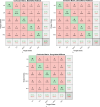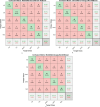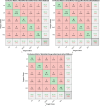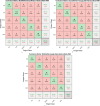Enhancing early detection of Alzheimer's disease through hybrid models based on feature fusion of multi-CNN and handcrafted features
- PMID: 39732953
- PMCID: PMC11682306
- DOI: 10.1038/s41598-024-82544-y
Enhancing early detection of Alzheimer's disease through hybrid models based on feature fusion of multi-CNN and handcrafted features
Abstract
Alzheimer's disease (AD) is a brain disorder that causes memory loss and behavioral and thinking problems. The symptoms of Alzheimer's are similar throughout its development stages, which makes it difficult to diagnose manually. Therefore, artificial intelligence (AI) techniques address the limitations of manual diagnosis. In this study, the images were enhanced and the active contour algorithm (ACA) was used to extract regions of interest (ROI) such as soft tissue and white matter. Strategies have been developed to diagnose AD and differentiate its stages. The first strategy is using XGBoost and ANN networks with the features of MobileNet, DenseNet, and GoogLeNet models. The second strategy is by XGBoost and ANN networks with combined features of MobileNet-DenseNet121, DenseNet121-GoogLeNet and MobileNet-GoogLeNet. The third strategy combines XGBoost and ANN networks with combined features of MobileNet-DenseNet121-Handcrafted, DenseNet121-GoogLeNet-Handcrafted, and MobileNet-GoogLeNet-Handcrafted leading to improved accuracy of the strategies and improved efficiency. XGBoost with hybrid features of DenseNet-GoogLeNet-Handcrafted achieved an AUC of 98.82%, accuracy of 98.8%, sensitivity of 98.9%, accuracy of 97.08%, and specificity of 99.5%.
Keywords: ACA; AD; ANN; CNN; Fusion features; RFE; XGBoost.
© 2024. The Author(s).
Conflict of interest statement
Declarations. Competing interests: The authors declare no competing interests.
Figures












References
-
- Jha, A. & Mukhopadhaya, K. Dementia due to Alzheimer’s disease (AD). Alzheimer’s Disease. 21–30. 10.1007/978-3-030-56739-2_2 (2021).
-
- Rayathala, J., P, V. & C, K. K. & Review on Alzheimer’s disease: Past, present and future. J. Innovations Appl. Pharm. Sci. (JIAPS). 28–31. 10.37022/JIAPS.V7I1.274 (2022).
-
- Gupta, V. B. et al. Retinal changes in Alzheimer’s disease— integrated prospects of imaging, functional and molecular advances. Prog. Retin. Eye Res.82, 100899 (2021). - PubMed
-
- Gentile, G., Mckinney, K. & Reboldi, G. Intensive blood pressure control and cognitive impairment in chronic kidney disease: The jury is still out. Eur. J. Intern. Med.101, 32–33 (2022). - PubMed
MeSH terms
Grants and funding
- IFP-22 010/Deputy for Research & Innovation, Ministry of Education through Initiative of Institutional Funding at University of Ha'il - Saudi Arabia
- IFP-22 010/Deputy for Research & Innovation, Ministry of Education through Initiative of Institutional Funding at University of Ha'il - Saudi Arabia
- IFP-22 010/Deputy for Research & Innovation, Ministry of Education through Initiative of Institutional Funding at University of Ha'il - Saudi Arabia
LinkOut - more resources
Full Text Sources
Medical

